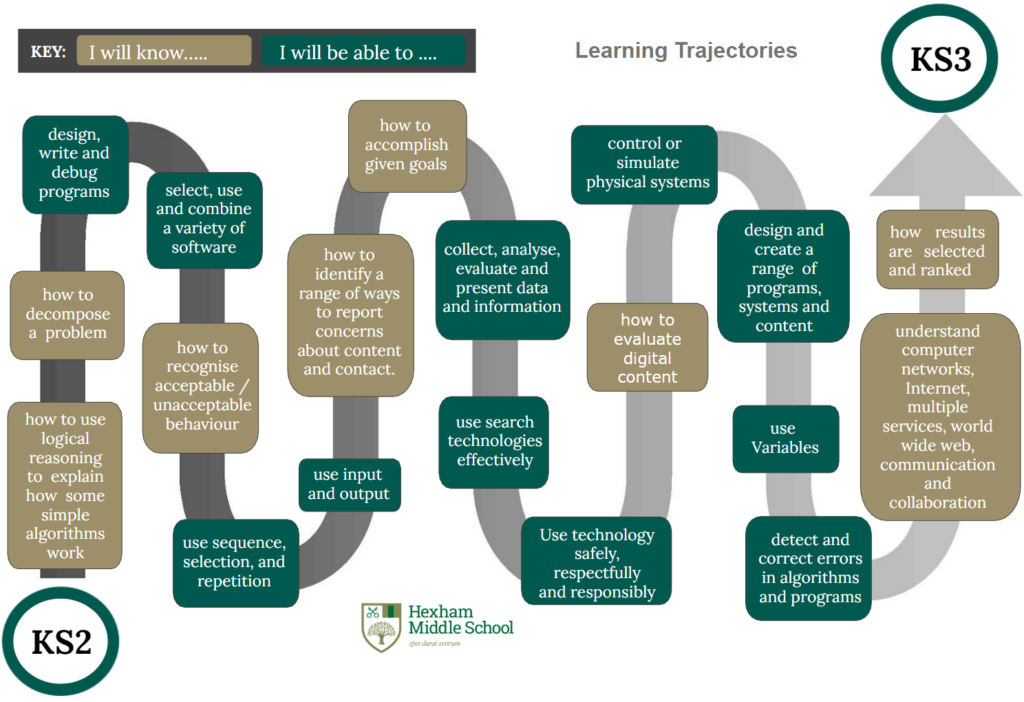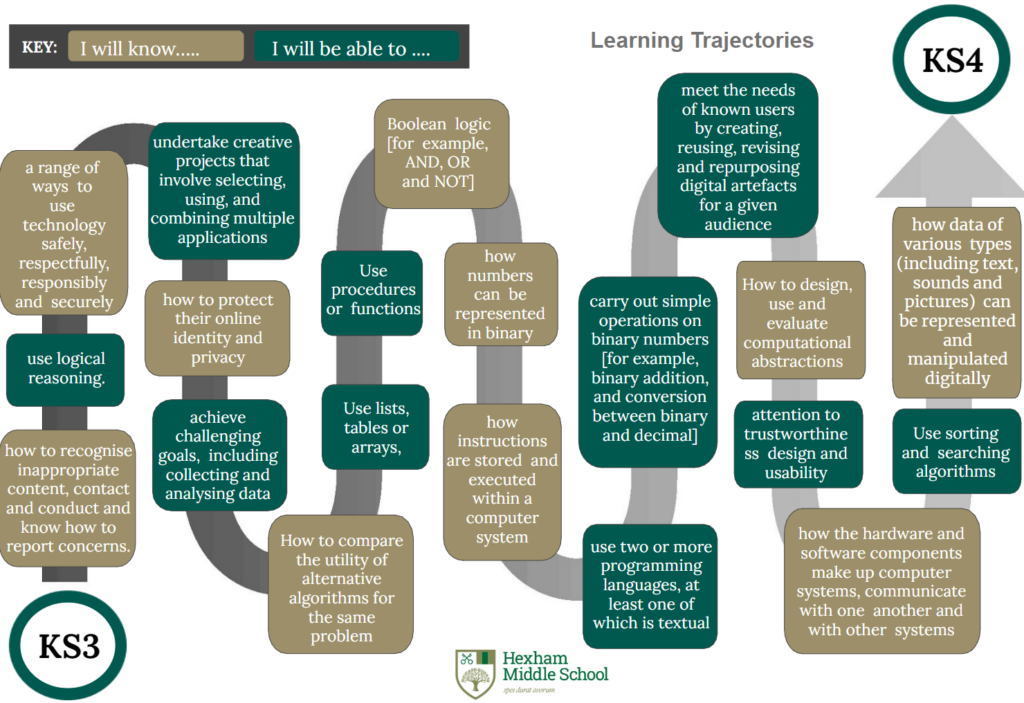Curriculum Leader
Mr O Williams
Intent
At Hexham Middle our aim is to provide a high-quality computing education which equips children to use computational thinking and creativity to understand and change the world. We want it to develop a life-long curiosity in and around the digital world. The curriculum will teach children key knowledge about how computers and computer systems work, and how they are designed and programmed. Learners will have the opportunity to gain an understanding of computational systems of all kinds, whether or not they include computers. During their time at HMS children will have gained key knowledge and skills in the ten strands of algorithms, networks, computer systems, media, data/information, design/development, effective use of tools, impact of technology, programming and safety/security. The objectives within each strand support the development of learning across the key stages, ensuring a solid grounding for future learning and beyond. This will enable our computing learners to tackle the ever-changing digital landscape ahead of them.
Implementation
We have created a comprehensive scheme of work to embed and cover every element of the computing curriculum. The knowledge and skills build year on year to deepen and challenge our learners. The implementation of the curriculum ensures a balanced coverage of the ten strands listed above, and is delivered through a spiral curriculum – five key strands (Computing Systems & Networks, Creating Media, Programming, Data & Information, Digital Citizenship), where each strand is revisited regularly to minimise the amount of lost knowledge. We have tried to alternate technical topics (e.g. coding) with more practical topics, such as graphics. This is intended to maintain engagement across the year. Staff are usually delivering the same topic across multiple year groups at the same time. This supports staff delivering the topics, ensuring the children get the best from them. The children will have experiences of all strands in each key stage, but the subject knowledge imparted becomes increasingly specific and in depth, with more complex skills being taught, thus ensuring that learning is built upon. For example, children in Key Stage 2 learn what algorithms are, they design, write and debug programs, explaining the thinking behind their algorithms using a block-based language program such as Scratch; progressing to learning text-based coding languages like Python at Key Stage 3. Formative and summative assessments are used throughout the curriculum, including verbal feedback, rubrics and written assessments.


Impact
Much of the subject-specific knowledge developed in our computing lessons equip pupils with experiences which will benefit them in high school, further education and future workplaces. We are trying to prepare them for a world we don’t yet know – technology advances so quickly. From research methods, use of presentation and creative tools and critical thinking, computing at Hexham Middle gives children the building blocks that enable them to pursue a wide range of interests. We also look for evidence through reviewing pupil’s knowledge and skills digitally through tools such as Google Suite and School 360. This means that pupils can access their work anywhere, any time. Teachers’ judgements are formed from a range of sources including classwork, homework and the use of frequent low-stakes assessments. There is regular moderation of judgements both internally and externally at computing cluster meetings.
Reading/Literacy
Keywords are identified through “buzzwords” linked to individual lessons or topics, and misconceptions are discussed following low-stakes assessments. Where relevant, written instructions are also coupled with video explanations to support our weaker readers. Coding requires careful attention to syntax – it is effectively a language in its own right – and students learn the precision required to solve each coding challenge. We have also created a super-curriculum that includes ideas for reading about our subject beyond the classroom.
Personal Development/Careers
Throughout our curriculum, career learning is interwoven into all units, where relevant. Career roles are highlighted and discussed, making sure that a wide variety of interests are catered for, enable pupils to aspire to careers they may not be aware. For example, ethical hackers, many media roles and environmental data analyst.
Useful Links/Resources
- Super Curriculum (PDF)
- Google Suite
- School 360 (External URL)
- Oak Academy (External URL)
- Typing Skills software, such as https://www.freetypinggame.net/
Curriculum Sequence
You can download a copy of the curriculum sequence for computer here.
SEND
All learners with additional needs access a broad and rich classroom experience with a well-planned curriculum both within and beyond the classroom. Pupils with additional needs are enabled to achieve well by:
- High quality planning, teaching and learning across the curriculum.
- Adaptations made in teaching and learning to ensure all pupils succeed and learn well.
- Staff responding to learners’ needs and adapting teaching as a result.
- Teaching staff planning and delivering a wide range of high-quality interventions and support sessions.
- High-quality ‘Pupil Profiles’ which ensure staff know each child as an individual, including how to support their learning.
- Where appropriate, an ‘Individual Education Plan’ with bespoke and individualised targets is implemented, and regularly reviewed.
- For learners with an ‘Education, Health and Care Plan (EHCP)’, a wide range of individualised targets and support strategies are implemented in a multi-agency approach.
- Coordinating our ambitious support in school alongside a multi-agency approach to ensure that all pupils achieve their full potential.
As part of our implementation model – the ’10 Elements of Great Teaching’ – our teaching and support staff will enable pupils with additional needs to thrive by:
- Planning well-sequenced lessons which build progressively in small steps.
- Implementing the school’s lesson design principles so that teachers gradually handover the learning through guided and independent practice.
- Maintaining a calm, focused, inclusive and positive environment for learning in all classrooms.
- Implementing a wide range of strategies to empower pupils to remember more over time and to check that this is the case.
- Using metacognitive strategies to encourage self-regulation and to plan, monitor and evaluate learning.
- Delivering expectations and instructions clearly in small steps.
- Teaching subject-specific vocabulary (tier 3), alongside tier 2 vocabulary, and ensuring that it is used and retained.
- Using a wide range of teaching resources and materials to support all learners including visual and audio resources.
- Using high-quality modelling in lessons through the ‘I do, we do, you do’ approach.
- Using a wide range of scaffolds to support learning including writing frames, planning structures, word processing.
- Providing high-quality worked examples which narrate the learning, steps and processes so that pupils develop their independence of learning.
- Using organisers such as ‘Knowledge Organisers’, diagrams, planning structures and writing frames to support pupils’ learning.
- Allowing pupils to record their ideas in a range of ways including, where necessary, by using online resources and visual/audio support.
- Providing word lists/vocabulary banks to support pupils’ access to learning.
- Using sentence stems to promote positive talk and discussion.
- Using flexible groupings in the classroom so that pupils can learn alongside and from each other.
- Implementing dyslexia-friendly approach to reading and writing tasks.
- Modelling thinking out loud strategies across the curriculum.
- Using a wide range of technologies including online resources, voice recording and visualisers to model worked examples.
